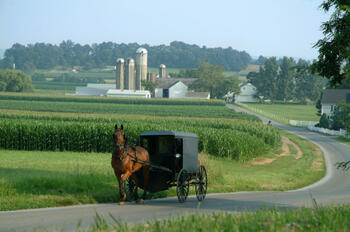
In Pennsylvania, public and private funds mainly are directed into areas where people live and where people vote. As a result urban Pennsylvania has significant advantages over rural communities in securing public funds and private investment.
Although rural Pennsylvania comprises a significant percentage of Pennsylvania’s geography it contains a very low percentage of the overall population and its political clout is dwindling. According to Trends in Rural Pennsylvania March/April 2003 overview of the state’s population, urban counties outnumber the population of rural by a ratio of more than 3 to 1.
Politically rural and small town Pennsylvania once wielded considerable power. The “T” which ran up the center of Pennsylvania and east to west across the northern tier of the state was key to Republican victories statewide. In recent elections, it has been the southeastern region that has dominated politics. It has reached the point where it can be safely stated that no candidate can win statewide in Pennsylvania without carrying at least one of the five southeastern counties.
All this puts rural Pennsylvania at a distinct disadvantage, particularly in terms of basic infrastructure. Rural Pennsylvania has 57,065 miles of highway compared to 62,577 in urban counties. Local governments receive only about 10 percent of state revenues from the Motor License Fund and the rest is funded by local taxes.
In rural Pennsylvania, because miles of roadway responsibility are funded by a smaller tax base per mile, the choice is between higher taxes or ignoring the problem. More and more, residents in small, rural communities are driving on outdated highways and over creaky bridges. In many ways, highway infrastructure is moving backwards in time as bridges close or become weight restricted isolating rural communities.
Mass transit is another issue in the divide. Pennsylvania has 46 fixed transit systems. Twenty-four serve small urban areas and another twenty service rural communities. This said the two systems that serve the cities of Philadelphia and Pittsburgh, SEPTA and PAAT, receive roughly 90 percent of all transit monies in the state.
Transit receives about $900 in annual state subsidies. These funds come from a wide-variety of sources and are distributed under a myriad of conditions most of which the rural systems cannot meet. The result is the budgets of rural systems must rely more on passenger receipts and local subsidies than the much larger systems.
In 2007, as part of an effort to find more funds for roads, bridges and transit, Act 44 was passed. Under this legislation Interstate 80 would be tolled. This superhighway runs through rural Pennsylvania. In blunt terms, the politics played out that rural Pennsylvania was being tolled to fund transit in Philadelphia. The only reason I-80 has not been tolled yet has been because the U.S. Department of Transportation rejected Pennsylvania’s proposal.
There are other dramatic differences between the two Pennsylvanias in terms of basis infrastructure. Census data show that 36 percent of people in rural Pennsylvania get their drinking water from wells or some other sources. There are 5,697 active drinking water systems in rural Pennsylvania of which 70 percent are owned by investors or individuals according to n Trends in Rural Pennsylvania May/June 2004. Most of the sewer and other basic water systems are antiquated. The American Society of Civil Engineers’ that rural Pennsylvania needs $5.26 billion invested over the next 20 years in drinking water infrastructure and more than $6 billion over the same period to update sewage.
Yet when Pennsylvania speaks about the upcoming stimulus, the primary voices are urban, epitomized by Governor Ed Rendell, a former Mayor of Philadelphia and fervent urbanist. We can expect that he will be working hard for more stimulus in the big cities, including for such things as the $800 million expansion of the Pennsylvania Convention Center which is now under way.(link to piece on this) Once again demographics and politics could be working against rural and small town communities where projects are on a much smaller scale, but equally important to the welfare of areas of rural Pennsylvania.
Like many similar places around the country, rural Pennsylvania has many assets that would benefit from new infrastructure. It is an area of tremendous natural beauty and bountiful recreational opportunities. Most of these areas have good school systems and are safe areas to live. They could contribute to the nation’s economic recovery and provide an alternative for many urban residents who want improved quality of life or are thinking about retiring to an area that is less expensive. The problem is we have to get our own state officials, and the Obama administration to start paying attention.
Dennis M. Powell is president and CEO of Massey Powell an issues management consulting company located in Plymouth Meeting, PA.












